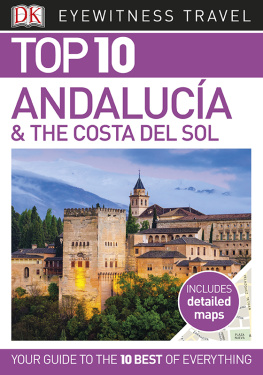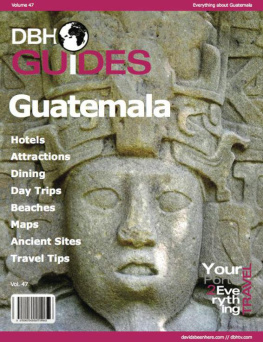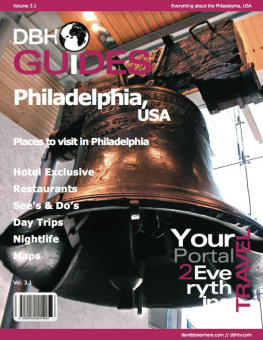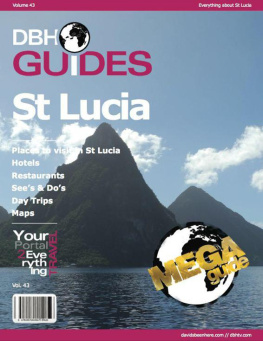
Davidsbeenhere.com
Granada, Spain
Mega City Travel Guide 2011
All Rights Reserved
Doma Publishing House 2011
About David

I am an avid traveler who doesnt shy away from the road less traveled. I have always believed that travel advice is better when made personable and portable. Davidsbeenhere.com is a complete travel site featuring the sights and sounds of the world and intended to make trip planning easier and informative for all travelers alike. DBH City Guides are one of the ways that I bring you better access to information about foreign destinations, and one step closer to the trip of your life. Whether you are traveling with loved ones or alone, it is my sincere hope that it helps you along your journey. My ultimate goal is to create guides in every country on Earth. The featured locations in this issue are brought to you in living color with the most essential information possible- precisely the way that I lived them and the way in which I hope you enjoy.
Granada, Spain
Granada, Spain lies at the foot of the frosted Sierra Nevada Mountains in Andaluca, which is a picturesque region with sprawling hillsides and miles of olive groves. Throughout its history, Granada has been a strategic city for its location near the Mediterranean Sea and its ample sources of running water- the rivers Beiro, Darro, and Genil.
By the end of the 5th century BC, Granada was a colony of the Greek kingdom and then became part of the ancient Roman Empire among with hundreds of other cities in the Iberian Peninsula. These were known to the Romans as Hispania. After the Umayyad Moors conquered Hispania in 713, Granada flourished under their rule for the subsequent 700 years until the city surrendered in 1492 during the Reconquista fueled by the Catholic monarchs Ferdinand II of Aragon and Isabella I of Castile. This surrender was one of the most significant events in the city's history and unfortunately resulted in the destruction of most of the mosques the Moors had built. In the same year that Granada was won by the Catholic Monarchs, Queen Isabella I commissioned Christopher Columbus' explorative voyage to the New World.
Granada is best known for its extraordinary Moorish fortress and palace- the Alhambra. Granada's old city, Albayzin, is also a testament to hundreds of years of Moorish occupation and boasts typical Arab narrow cobblestone streets. The Alhambra and its gardens were declared a UNESCO World Heritage site in 1984, and has remained an iconic and popular tourist site in Spain.
Granada is a city rich with history, culture, and architecture. Tourists from all over the world come to Granada to enjoy its main treasure the Alhambra. Granada's location allows for breath-taking views of the Sierra Nevada and easy commutes to both skiing and Mediterranean beaches. It is an ideal place for both romantic and family get-a-ways. Granada is a charming gem in Andaluca, and although its days can be quite hot, the nights are cool and serene. It is no wonder why this city was lusted after and fought for by so many realms.
Table of Contents
Hotel
Hotel Palacio de los Navas

In an unassuming location on the corner of Navas and San Matias Street, stands the boutique-style Hotel Palacio de los Navas. Once through its main glass door, guests are greeted by one of the personable and knowledgeable ladies at the front desk. The Palacio de los Navas' courtyard and pillars will immediately catch your eye, and you will quickly realize you are standing in the transformed 16th century home of the Navas family, which were assistants of King Ferdinand II and Queen Isabella I.

With all its modern and luxurious amenities, guests can enjoy a tranquil stay in the lively historical center of Granada. The hotel contains 19 guest rooms on four floors. The rooms are located along wrapping balconies, and each opens to the view of the luminous courtyard in the lobby below. Hotel Palacio de los Navas opened in 2006 after years of restoration to preserve its 16th century charm. The giant pillars in the lobby were fortunately retained and continue to provide the main support of the structure.
Each guest room is a soothing retreat from the bustling streets just outside of the hotel. The white bed linens are perfectly ironed and crisp, and the soft wooden accents make each room feel like a bedroom in someone's home. Each bathroom is stocked with extra amenities such as toothbrushes and body scrubs to relax with after a long day of sightseeing. There is free WIFI in the lobby, but guests can request cable Internet in their rooms at no additional charge.

It is important to know that booking your rooms in advance at Palacio de los Navas is recommended. The rooms go fast in the months of March through April and October through November. Rooms cost approximately 133 Euros per night during these busy months. Any other time of year, however, the rooms are available for approximately 70 Euros per night.
For the past 5 years Palacio de los Navas has hosted guests from France, Belgium, Germany, and numerous other countries. International guests enjoy the hotel's cozy atmosphere and the convenience of the staff's fluency in various languages. If you come to Granada with a car, parking is available at a nearby garage for 15 Euros per day. Breakfast is available daily in the hotel's comfy breakfast room, and includes a selection of pastries and cheeses, coffee and tea, as well as cereal, yogurt, and fresh juice. You will find that the hotel staff is committed to comprehensive hospitality in order to ensure that your stay is la mode. What stood out to me was the hotel's impeccable cleanliness and the staff's attention to detail.

Info:
Calle Navas, 1
Granada, Spain 18009
Phone: +34 958 215 760
Email:
The Alhambra

Alhambra literally translates into "the red one" in Arabic. The Alhambra monument is an outstanding example of Moorish design. It sits on a plateau overlooking Granada's old city and spans approximately 1,530,000 square feet. Construction began on the Alhambra in 1237 with Muhammad Al-Ahmar I, the founder of the Nasrid Dynasty. Work continued and additions made with the seventh heir to the Nasrid throne, Yusuf I. Muhammed Boabdil XIII, the last Muslim Sultan to rule Granada before the Reconquista, surrendered Alhambra to the Catholic Monarchs on January 2nd 1492. Each Muslim ruler continued the "paradise on Earth" theme that can still be seen today.
For the next 24 years after the surrender, the Alhambra monument was restored and altered by the Spanish Royal Family. The Palaces were used by local government officials for meetings and as headquarters for Spanish authorities in the area. Alhambra's colorful history comes at no surprise once you step onto its lush landscaped grounds. There are four sections of the Alhambra- Alcazaba, Nasrid Palaces, Partal, and Generalife (pronounced Hen-er-al-eef-eh.) I recommend that you enter the Alhambra at the official entrance pavilion/ ticket office and make your way through Generalife, El Partal, Alcazaba, and leave the Nasrid Palaces for last. This way, you will experience the best for last. Each of the Nasrid Palaces (Mexuar, Comares, and Los Leones) was built by a different Arab ruler of the Nasrid Dynasty as testament to each one's authority and affluence.
Next page





















